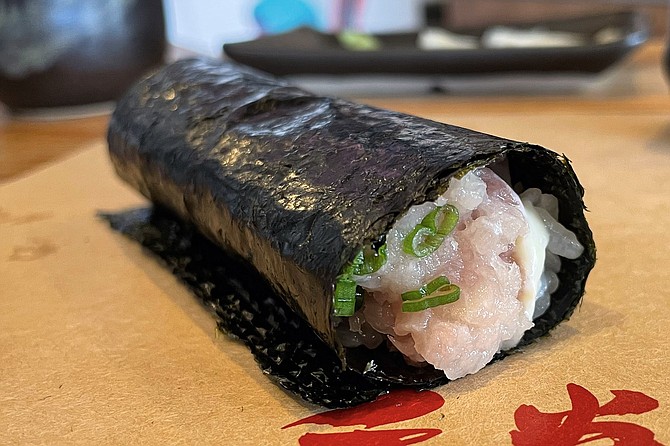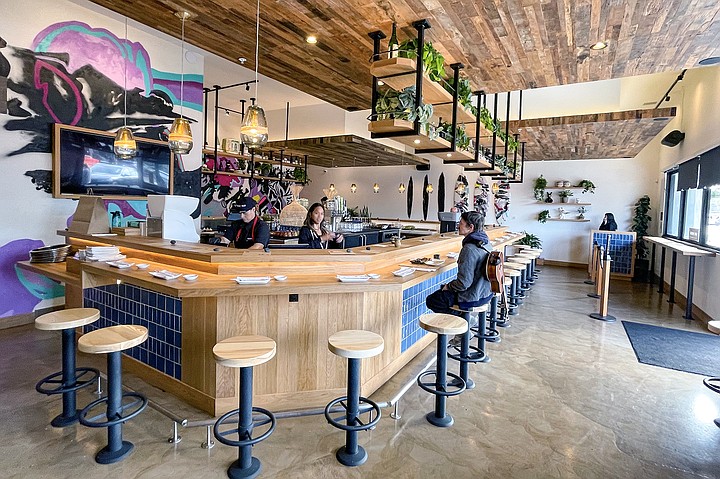 Facebook
Facebook
 X
X
 Instagram
Instagram
 TikTok
TikTok
 Youtube
Youtube

Just about every sushi joint makes room on its menu for temaki, better known as hand rolls. However, there is a point to going to a dedicated hand roll bar. While a conventional sushi restaurant serves conical hand rolls — it’s impossible not to mention their resemblance to ice cream cones — a true temaki dealer opts for a tubular shape that more evenly balances the distribution of rice, fish, and seaweed.
More importantly, each hand roll is made to order, and served one at a time. This contemporary style of temaki is meant to be enjoyed immediately, while the seaweed remains crisp, the rice warm, and the fish cool.
On top of that, there’s an entirely different point to visiting recent Encinitas arrival, Temaki Bar. And that would be the involvement of chef JoJo Ruiz, the local seafood maven who’s routinely recognized by the James Beard Foundation for his adherence to sustainable seafood practices. Basically, the fish served by this sushi spot doesn’t only stand out for its quality, but for putting a restless mind at ease: here, you know it all came from a good place, pulled out of the ocean by one of the good guys.

And that thought did pass through my mind when I opted for one of the premium hand rolls on the menu, a $10 temaki made with toro, the fatty tuna belly so desirable that global demand has endangered several tuna species. I could indulge, guilt-free, presuming this fish was not one of them.
Other top shelf hand rolls at Temaki Bar include king crab ($15) and Maine lobster ($9), however much of the menu sticks to sashimi-grade fish we’re all more accustomed to. Salmon, yellowtail, scallops, and albacore hand rolls go for a reasonable $6 apiece, but you’ll also find this in three-, four-, and five-roll sets, prices starting at $15 for a modest discount. This is a great place to start, because fresh hand rolls just keep on coming.

To facilitate this, most of the restaurant’s seats will be found at the venue’s two-tier, wraparound bar. Up top, each place is set with a clean piece of paper, weighed down by a rock, where the a chef may place a new temaki the moment it’s rolled. The lower tier is where you’ll find your plate, chopsticks and dipping bowl — assuming your hand rolls even make it that far. Mine did not. I just grabbed each off the top and ate it in three bites, only pausing between bites long enough to savor the ideal combination of texture, temperature, and taste.
That said, Temaki Bar does offer non-handroll sushi, including an assortment of nigiri, sashimi, and cut rolls.
In fact, I found the biggest surprise at Temaki Bar were the cut rolls. Not only are these not hand rolls, they go in quite the opposite direction. There’s a large maki rolling machine behind the bar — about the size and shape of a bread maker — and it automates the rolling process. A tray pulls nori into the device, returning the sheet seaweed a moment later, perfectly coated in sushi rice. Once fish and other fillings top the rice, the tray folds up and rolls the whole thing into the familiar maki shape. Drop the roll into the top of the machine, and it instantly emerges from the bottom, uniformly sliced into bite size pieces.
It surprised me at first, but I think I get it. We’ve seen temaki restaurants come and go in San Diego, and some of that probably has to do with the demands of one-at-a-time handroll service. If a machine like this may keep guests’ bellies full without pulling too much attention away from the chefs, maybe this Temaki Bar will stick around more than a couple years. And I hope it does, because the whole hand roll thing kind of makes sushi feel special again.


Just about every sushi joint makes room on its menu for temaki, better known as hand rolls. However, there is a point to going to a dedicated hand roll bar. While a conventional sushi restaurant serves conical hand rolls — it’s impossible not to mention their resemblance to ice cream cones — a true temaki dealer opts for a tubular shape that more evenly balances the distribution of rice, fish, and seaweed.
More importantly, each hand roll is made to order, and served one at a time. This contemporary style of temaki is meant to be enjoyed immediately, while the seaweed remains crisp, the rice warm, and the fish cool.
On top of that, there’s an entirely different point to visiting recent Encinitas arrival, Temaki Bar. And that would be the involvement of chef JoJo Ruiz, the local seafood maven who’s routinely recognized by the James Beard Foundation for his adherence to sustainable seafood practices. Basically, the fish served by this sushi spot doesn’t only stand out for its quality, but for putting a restless mind at ease: here, you know it all came from a good place, pulled out of the ocean by one of the good guys.

And that thought did pass through my mind when I opted for one of the premium hand rolls on the menu, a $10 temaki made with toro, the fatty tuna belly so desirable that global demand has endangered several tuna species. I could indulge, guilt-free, presuming this fish was not one of them.
Other top shelf hand rolls at Temaki Bar include king crab ($15) and Maine lobster ($9), however much of the menu sticks to sashimi-grade fish we’re all more accustomed to. Salmon, yellowtail, scallops, and albacore hand rolls go for a reasonable $6 apiece, but you’ll also find this in three-, four-, and five-roll sets, prices starting at $15 for a modest discount. This is a great place to start, because fresh hand rolls just keep on coming.

To facilitate this, most of the restaurant’s seats will be found at the venue’s two-tier, wraparound bar. Up top, each place is set with a clean piece of paper, weighed down by a rock, where the a chef may place a new temaki the moment it’s rolled. The lower tier is where you’ll find your plate, chopsticks and dipping bowl — assuming your hand rolls even make it that far. Mine did not. I just grabbed each off the top and ate it in three bites, only pausing between bites long enough to savor the ideal combination of texture, temperature, and taste.
That said, Temaki Bar does offer non-handroll sushi, including an assortment of nigiri, sashimi, and cut rolls.
In fact, I found the biggest surprise at Temaki Bar were the cut rolls. Not only are these not hand rolls, they go in quite the opposite direction. There’s a large maki rolling machine behind the bar — about the size and shape of a bread maker — and it automates the rolling process. A tray pulls nori into the device, returning the sheet seaweed a moment later, perfectly coated in sushi rice. Once fish and other fillings top the rice, the tray folds up and rolls the whole thing into the familiar maki shape. Drop the roll into the top of the machine, and it instantly emerges from the bottom, uniformly sliced into bite size pieces.
It surprised me at first, but I think I get it. We’ve seen temaki restaurants come and go in San Diego, and some of that probably has to do with the demands of one-at-a-time handroll service. If a machine like this may keep guests’ bellies full without pulling too much attention away from the chefs, maybe this Temaki Bar will stick around more than a couple years. And I hope it does, because the whole hand roll thing kind of makes sushi feel special again.
Comments